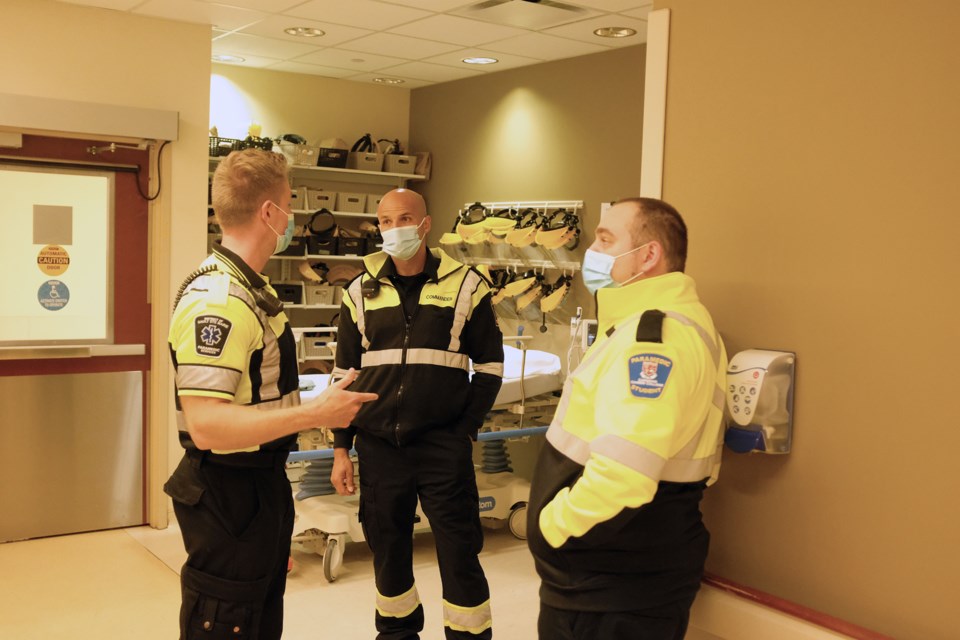The addition of an offload nurse provided by Sault Area Hospital resulted in a small improvement in offload delays last month, but the paramedic service’s chief says the full potential of the program won’t be felt until the hospital can fully staff the position.
Chief Katie Kirkham presented the most recent offload delay stats to the District of Sault Ste. Marie Social Services Administration Board (DSSAB) on Thursday.
The service recently received funding from the Ministry of Health to support the hiring of an offload nurse in the hospital’s Emergency Department for 12 hours per day, seven days a week. The intent is to reduce the amount of time paramedics are waiting with patients while a bed or Emergency Department staff are unable to accept them, referred to as an offload delay.
The Sault Ste. Marie Paramedic Service receives the funding from the ministry for the offload nurse and reimburses the hospital for the hours an offload nurse is provided.
Kirkham said the hospital was able to provide an offload nurse on 14 days in April. That, along with a decrease in the number of patients brought to hospital, resulted in 116 fewer total hours of offload delay recorded versus the same month in 2022.
“Every time they are able to take more patients on themselves, the better for us,” said Kirkham of the hospital’s offload nurses. “You have to remember those offload hours represent the amount of time that a paramedic is spending in the [Emergency Department] watching patients, so a reduction is good.”
The hospital was only able to provide offload nurses for 14 days last month due to ongoing staffing shortages, said Kirkham. That meant for the remaining days paramedic staff had to take on the role of accepting patients at the hospital for a total of 348 hours in April.
“It does free up some ambulances but it still ties us up in the emerg department and the patient isn’t getting the care they should be getting under the scope of the nurses,” said Kirkham of the paramedics covering the hours the hospital is unable to staff an offload nurse.
In March, a Sault Area Hospital spokesperson told SooToday the hospital is experiencing the same nursing shortage that is affecting hospitals across the province.
The longest offload delay last month was five hours and 51 minutes.
Kirkham said she is in the process of applying for funding from the ministry for 24/7 offload nurse coverage, but noted the coverage Sault Area Hospital is able to provide may be reduced.
“The [Emergency Department] management have let us know they are going to have significant staffing issues until about September,” said Kirkham. “We have already started to see a decline in the number of offload shifts being filled by nurses in this month, so I think we are going to continue to see limited staffing until September.”
DSSAB CEO Mike Nadeau said he recently met with senior staff at Sault Area Hospital to continue to discuss a solution.
“It is a problem that is impacting the community,” said Nadeau. “There is no magic silver bullet, we are just trying to chip away at it slowly and I am optimistic that, through collaboration and through help from the province and help from the board, that we are going to slowly start to figure this out.”
The total number of patients transported to hospital decreased in April 2023, with 802 transported versus 880 in the same month last year.
Kirkham said a number of factors are helping to bring that number down, including the recent introduction of the Community Paramedic program. The paramedics who work in that program make proactive visits to retirement residences and in-home visits to high risk patients in hopes of reducing the number of visits they make to the Emergency Department.
“We are starting to see a reduction after implementing that program. A lot of our regular clients aren’t reaching out to us as often through the land ambulance side,” said Kirkham. “We are seeing that those people are reducing the number of times they are calling for an ambulance because they are already being seen on a regular basis by community paramedics.”
